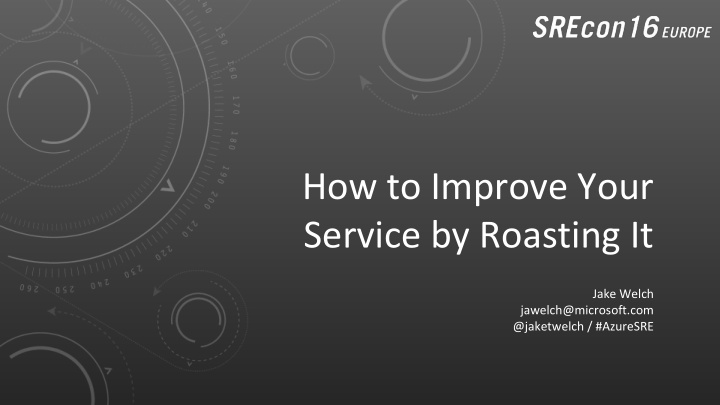



How to Improve Your Service by Roasting It Jake Welch jawelch@microsoft.com @jaketwelch / #AzureSRE
Developer
Developer
Developer
Developer (furiously optimizing)
Developers
Developers
Developers Front-End Back-End
Developers Web Team App Logic Auth Team File / DB
Developers Web Team App Logic Auth Team File / DB Video Ads
Developers Web Team App Logic Auth Team File Video Ads Search DB Chat
Teams will organically implement the service lifecycle to fit their needs From source control and deployment to capacity planning
Web Team App Logic Auth Team File SRE Video Ads Search DB Chat
Welcome to The Pit of Opportunity
Engaging with Product Teams • Only they know where debt lies, what it looks like, where their service fails • How do you get a product team to open up and work with you? • Is there a common understanding of SRE, agreement on goals? We can't help you if you won't tell us where it hurts
Service roast Pronunciation: \ ˈ s ə r-v ə s\ \ ˈ r ō st \ n. A series of meetings at which a service is subjected to good-natured but frank discussions to uncover design/process flaws, scale limits or other shortcomings
What is a Service Roast? • Goal: Expose and understand the warts, wrinkles, design flaws, shortcomings and problems everyone knows a service has but doesn’t want to talk about • Covers the entire service lifecycle from Development to Disaster Recovery • Outcome: Understanding and a shared backlog of opportunities for improvement You can and should do this for SRE-built services
Why Do This? • Builds relationships and trust between the teams • Speeds up ‘newbie to expert’ process • Exposes details that otherwise would be difficult (or painful) to learn of • Creates a shared backlog of improvements
Guidelines: Working Together • Requires investment from SRE and product teams • Get real contributors in the room (go away managers) • End to end requires ~10 hours over several weeks • 45 minute meetings avoid emotional fatigue
Guidelines: Tone • Clarity of purpose and tone are key • Not an attack on the service or past choices • ‘Why’ questions are judgmental
Example Questions ✔ How does ${feature} work? ✘ Why did/didn’t you … ? ✔ When do these two pieces communicate? ✘ Why don’t you instead … ? ✔ What part of the system handles ${feature}? ✘ Why can’t you just … ? ✔ Where are user requests routed? ✘ Why aren’t you simply … ?
Roles Service Owners SME experts on service providing insights Roast Participants Ask questions, gain clarity on service (typically SRE) Scribe Keeps track of interesting tidbits, actions, learnings Roast Master Impartial moderator not otherwise involved in the engagement
The Roast Master • Impartial moderator with conflict resolution experience • Focuses on language, tone and body language of participants • De-escalates conversations as necessary • Decides when to call the meeting off Strongly recommend implementing this role
Meeting Agenda • Choose a single area or subsystem to drill into • Moderator provides overview of guidelines and sets tone • SME provides an overview using whiteboards, diagrams as needed • Sessions are interactive: ask questions, clarify, dispel misinformation • Moderator keeps conversation on topic • Scribe tracks off-shoots for future meeting topics
Service Roast Sample Topics Service Overview What is it, who uses it, where does it fit in overall Technical Architecture Overview, upstream dependencies, sub-components Development Process Source control, external dependencies, build, test, tools Change Management / Deployment Process, technology, cadence, gates, rollback Configuration Management Process, technology, source control Demand Forecasting, Capacity How do you shift load, or scale? How do you load test? Management Can you shed load? SLAs, SLI, SLOs, KPIs, etc. What are your targets? Are you meeting them? Monitoring, Logging, Diagnostics, Tickets How do you monitor, diagnose? How noisy? Incident Response, production playbook, How do you respond to issues? What is your waste case disaster recovery, backup/restore plan? Do you use it regularly? Review of Past Outages, War Stories What has gone wrong previously? How was it fixed?
Meeting Closure • At the end of the meeting: • The next topic is chosen • Adjustments are discussed for future sessions (new topics, participants, etc.) • The scribe summarizes key learnings and opportunities identified in a centralized doc • At the end of the series • Postmortem the engagement • Improvement items are jointly prioritized and bugs/tasks opened
Gotchas • Things can be said in the room that don’t leave (except the fix) • Don’t do this if you think it will degrade relationships between the teams • Don’t compare one service to another Each service will be at different maturity points - that’s ok! • When the product team is talking to each other, don’t stop them - listen harder
Summary • A Service Roast can be a great tool to safely gain E2E service understanding • Expectations and tone are critical success components • Managing emotions is critical to a safe discussion environment • Multiple, 45 minute meetings are best to cover all areas • The roast master role helps smooth over bumps in the process
Questions? Jake Welch jawelch@microsoft.com @jaketwelch / #AzureSRE
Recommend
More recommend